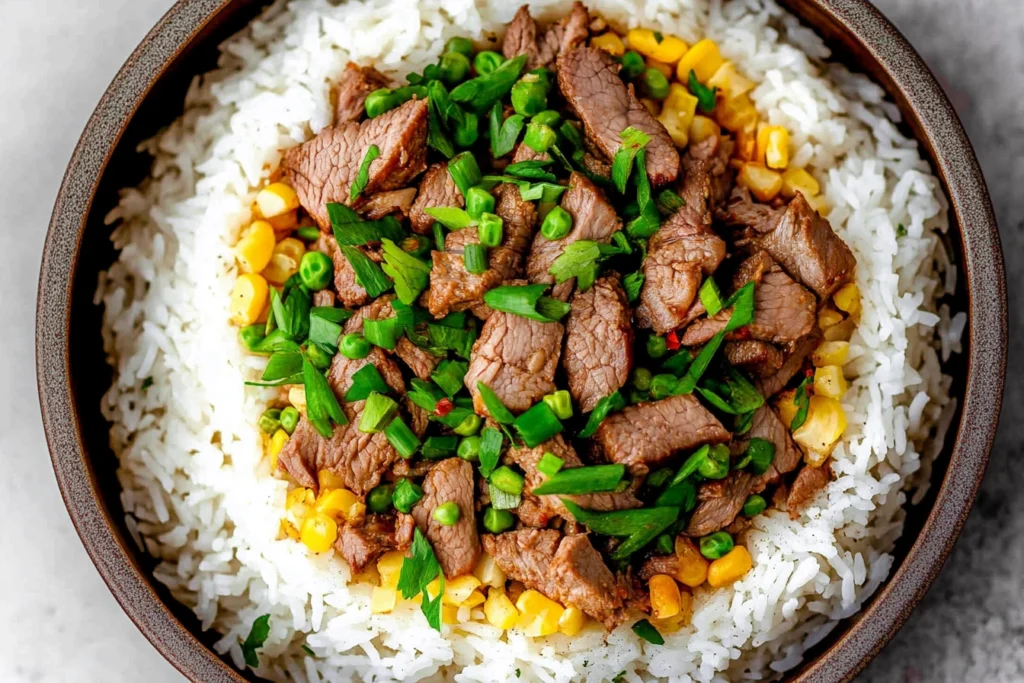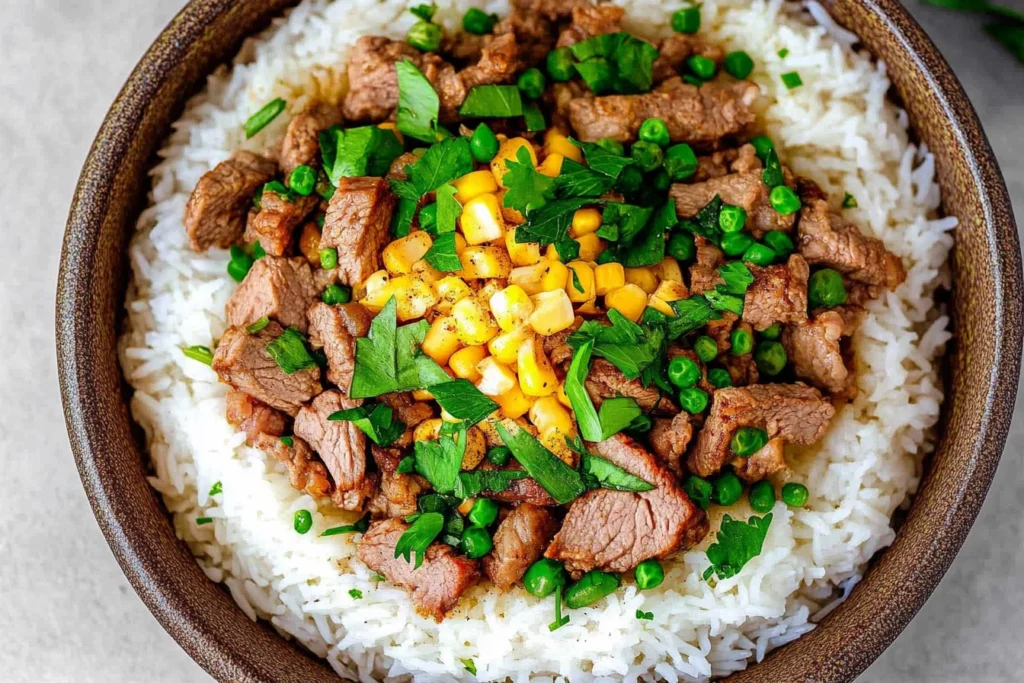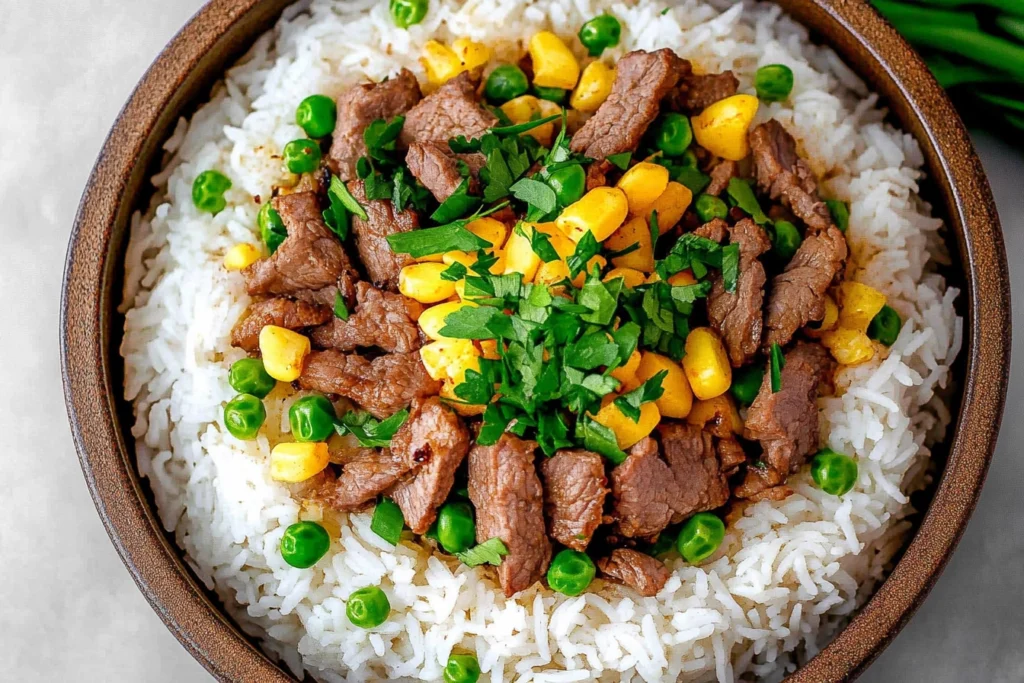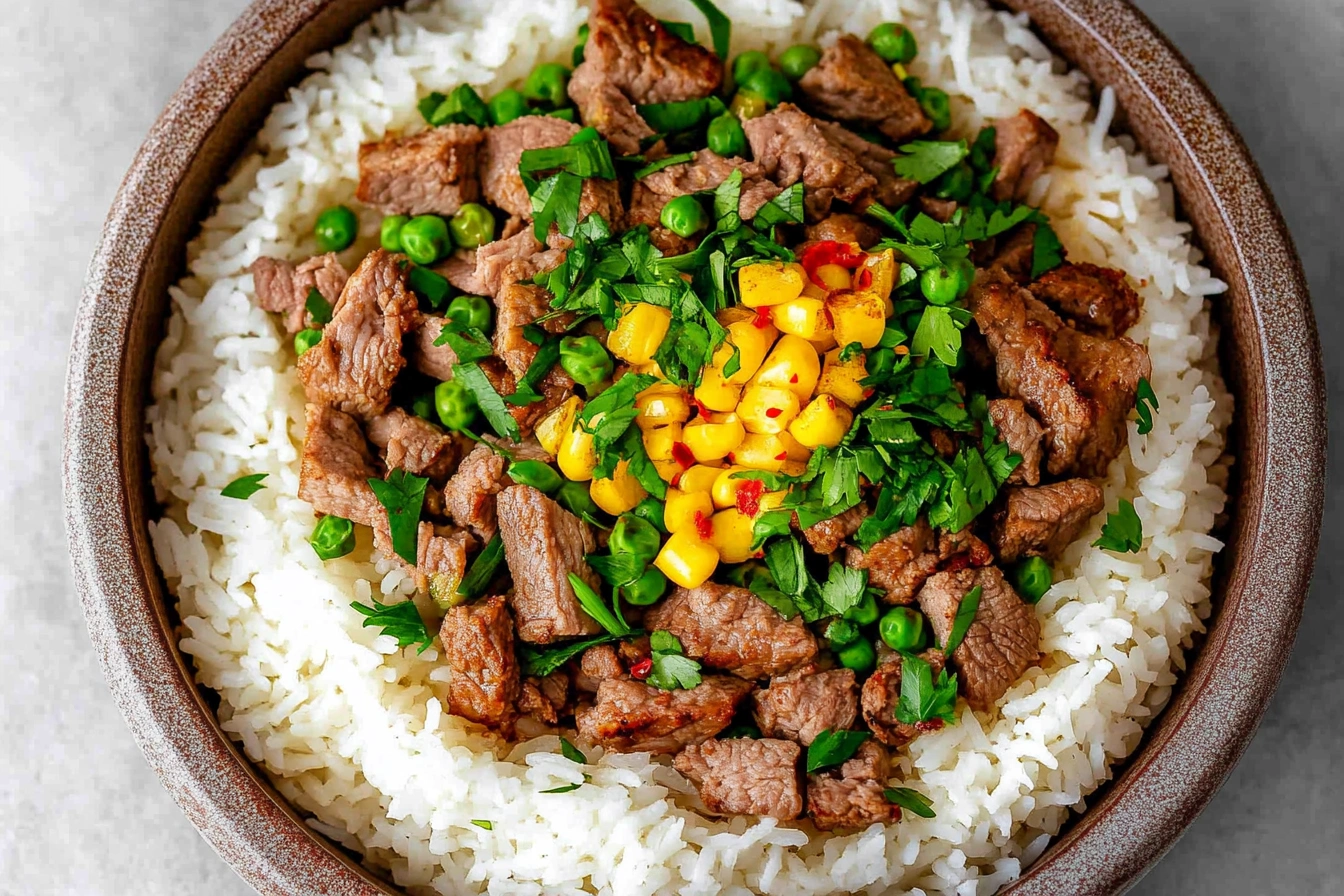Why You’ll Love This Beef Pepper Rice Recipe
Imagine this: it’s a busy weeknight, and all you want is a warm, comforting meal without the hassle of a lengthy cooking process. Beef Pepper Rice is the perfect solution. Combining the tender goodness of beef with the aromatic richness of pepper and a buttery finish, this dish captures the heart and soul of restaurant-quality meals right in your kitchen. And best of all? It’s easy to make.
This easy Beef Pepper Rice recipe lets you enjoy the depth of flavor you’d find in popular Asian dishes, yet you don’t need any fancy cooking techniques or ingredients. Perfect for anyone craving a cozy, home-cooked meal, this dish is both beginner-friendly and quick, making it an ideal option for dinner any night of the week.
Table of contents

Ingredients List: All You Need for Beef Pepper Rice
Having all your ingredients ready and measured before you start cooking can make the whole process smooth and enjoyable. Here’s a quick breakdown of what you’ll need for this recipe.
| Ingredient | Quantity |
|---|---|
| Beef sirloin or ribeye | 200 grams, sliced |
| Cooked white rice | 2 cups |
| Bell pepper (red or green) | 1 medium, diced |
| Soy sauce | 2 tbsp |
| Garlic (minced) | 1 clove |
| Black pepper | 1 tsp |
| Butter | 1 tbsp |
| Green onions (for garnish) | 2 tbsp, chopped |
Ingredient Tips
- Beef Options: While sirloin or ribeye offers a tender and juicy texture, you can substitute it with any other cut that’s easy to slice thinly. For a leaner alternative, try using beef tenderloin.
- Veggie Variations: Although bell peppers add color and a subtle sweetness, feel free to experiment with other veggies, like mushrooms or snap peas, to personalize the dish.
- Flavor Boost: You can enhance the recipe by adding a dash of sesame oil for a richer, nuttier flavor.
Step-by-Step Instructions on How to Make Beef Pepper Rice
This section guides you through every part of the cooking process, helping you achieve that perfect balance of flavors.
Step 1: Prepare the Ingredients
Before starting, make sure all your constituents are ready
- Chop the bell pepper and green onions.
- Slice the beef thinly to ensure it culinarians snappily and evenly. Thinner slices absorb more flavor from the seasoning.
Step 2: Cook the Rice
If you have leftover rice, you’re already one step ahead. This recipe is a fantastic way to use it. However, if you’re starting fresh, cook your rice following package instructions until it’s light and fluffy. Let it cool a bit before adding to the pan—this helps it keep its shape while frying.
Step 3: Sauté the Beef
In a large skillet or wok, add a little oil and heat it over medium-high. Once the pan is hot:
- Add the sliced beef and cook until browned, stirring sometimes. This should take about 3-4 minutes.
- Pro Tip: In the last minute of cooking, add the minced garlic to the beef. This timing helps the garlic release its full flavor without burning.
Step 4: Combine Ingredients
Now that your beef is cooked and fragrant, it’s time to bring the dish together:
- Add the cooked rice to the skillet along with the diced bell pepper and soy sauce.
- Sprinkle the black pepper evenly over the rice mixture. Use as much pepper as you like—it’s what gives this dish its signature kick.
Stir everything together, letting the rice soak up the juices and flavors from the beef.
Step 5: Add Finishing Touches
To give this dish a melt-in-your-mouth finish:
- Add the butter to the center of the rice mixture. Allow it to melt gradually, infusing the rice with a rich, creamy taste.
- Once everything is well combined, garnish with green onions. The onions not only add a vibrant color but also a fresh, crisp flavor that contrasts beautifully with the peppery beef.

Tips for Perfecting Beef Pepper Rice
Making Beef Pepper Rice is simple, but these extra tips will help elevate your dish to restaurant-quality. From ingredient selection to cooking techniques, here’s how you can ensure a perfectly balanced, flavor-packed meal every time.
1. Choosing the Best Beef Cut
The quality of your beef will make all the difference in the final taste and texture of your dish. Here’s what to consider when choosing your beef:
- Tender Cuts: Opt for tender cuts like sirloin or ribeye. These cuts cook quickly and stay juicy, which is ideal for stir-fries. They’re also easy to slice thinly, allowing the flavors to absorb evenly.
- Lean Options: If you prefer leaner meat, consider using beef tenderloin. It’s a great option that’s both tender and lower in fat. For extra tenderness, marinate the beef for 30 minutes before cooking in a mixture of soy sauce, oil, and a pinch of sugar.
- Other Meat Choices: If you prefer a different protein, chicken breast or tofu are excellent substitutes. Just slice the chicken thinly or use firm tofu, ensuring it’s pressed to remove excess water.
2. Perfecting the Rice Texture
The texture of your rice plays a huge role in the final dish. Here are a few tips to ensure your rice is light, fluffy, and perfect for stir-frying:
- Use Fresh, Cold Rice: Freshly cooked rice can become mushy when stir-fried. If possible, use day-old rice or let freshly cooked rice cool to room temperature before using it. The grains firm up and become less sticky, making them easier to fry.
- Choose the Right Rice: For the best texture, Jasmine rice or short-grain rice is ideal. Both types are slightly sticky, which helps the rice hold together during stir-frying, absorbing the flavors of the beef and soy sauce.
- Don’t Overcrowd the Pan: If you’re making a larger batch, cook the rice in batches to avoid overcrowding the skillet. This ensures the rice gets crispy and evenly mixed with the beef and seasonings.
3. Balancing the Seasonings
Beef Pepper Rice thrives on its simple yet bold flavors, but getting the seasoning just right is key. Here’s how to find the perfect balance:
- Adjust the Soy Sauce: The soy sauce is a major source of salt and umami in this dish. Start with 2 tablespoons and adjust to taste. If you like a more savory flavor, you can add a bit more soy sauce, but be careful not to overpower the dish.
- Black Pepper: The pepper is what gives this dish its signature kick. Feel free to adjust the amount of black pepper depending on your heat tolerance. If you want more heat, use freshly cracked pepper for a sharper, more aromatic flavor.
- Add Sweetness (Optional): A tiny bit of sugar or honey can help balance out the saltiness and spice, bringing a subtle sweetness that enhances the flavor profile.
- Season to Taste: Don’t hesitate to taste your dish as you go along and adjust the seasonings to your preference. A splash of sesame oil at the end can also add depth and a hint of nuttiness.
4. Cooking the Beef to Perfection
The beef should be cooked quickly to preserve its tender texture. Here are some tips for getting it just right:
- Don’t Overcook the Beef: Beef cooks quickly, especially when sliced thinly. Cook it for 3-4 minutes until it’s just browned. Overcooking it will lead to tougher meat, so stay vigilant.
- Add Garlic at the Right Time: Garlic cooks quickly and can burn easily, turning bitter. To avoid this, add it to the pan during the last minute of cooking the beef. This ensures the garlic softens and releases its flavors without burning.
- High Heat: Make sure the skillet or wok is hot enough to sear the beef properly. A high cooking temperature ensures that the beef develops a nice sear on the outside while staying tender on the inside.
5. Incorporating Vegetables for Extra Flavor
While bell peppers are the classic choice, feel free to get creative with your vegetable additions. Here’s how to take the veggie aspect up a notch:
- Bell Peppers: Red, yellow, or green bell peppers are all great for their sweetness and vibrant color. Dice them into small pieces so they cook evenly and blend well with the rice and beef.
- Other Vegetables: Try adding vegetables like snap peas, mushrooms, or carrots for added texture and flavor. Snap peas bring a fresh crunch, while mushrooms add an earthy flavor that complements the beef.
- Quick Stir-Fry: Remember to cook the vegetables just until they’re tender-crisp. Overcooking can cause them to lose their color and crunch, which is what makes them so enjoyable in this dish.
6. Finishing Touches to Elevate the Dish
The finishing touches can really elevate the flavors and presentation of your Beef Pepper Rice. Here are a few ideas to make it extra special:
- Butter for Richness: Adding a tablespoon of butter towards the end infuses the dish with a creamy, rich flavor that balances out the peppery kick.
- Garnishes for Color and Freshness: Top your Beef Pepper Rice with chopped green onions, which not only add a burst of color but also a fresh, oniony crunch. You can also add sesame seeds for extra texture and flavor.
- Fried Egg: If you want to make the dish more indulgent, top it with a fried egg. The runny yolk mixes beautifully with the rice, adding richness and creaminess.
- A Drizzle of Sesame Oil: A final drizzle of sesame oil just before serving gives the dish a nutty, toasted flavor that rounds out the taste profile.
7. Making It Spicy (If You Like Heat)
For spice lovers, here’s how to amp up the heat without overwhelming the dish:
- Chili Flakes: Add a pinch of chili flakes or fresh chili slices during cooking to give the dish an extra layer of heat.
- Spicy Soy Sauce: Consider using chili-infused soy sauce or adding a spoonful of chili paste to the soy sauce for an extra spicy kick.
With these tips, you can tailor your Beef Pepper Rice to your exact taste, ensuring it’s always perfectly seasoned and cooked to perfection.
Nutritional Information
For those looking to keep track of their intake, here’s a general breakdown of the nutrients in one serving:
| Nutrient | Per Serving |
|---|---|
| Calories | 450 kcal |
| Protein | 25g |
| Carbohydrates | 55g |
| Fat | 15g |
While this meal is satisfying and flavorful, it’s also relatively balanced, providing a good mix of proteins, carbs, and fats. Perfect for refueling after a busy day!

Frequently Asked Questions about Beef Pepper Rice
To help you make this dish to perfection, here are answers to some common questions:
Can I use a different type of meat for this nest recipe?
Absolutely! Chicken or tofu work well as substitutes, allowing you to personalize this dish to your taste preferences.
What is the best rice to use for Beef Pepper Rice?
Jasmine or short-grain rice is ideal because of its slightly sticky texture, which holds up well when mixed with other ingredients.
How can I store leftovers?
Store any leftover Beef Pepper Rice in an airtight container in the fridge for up to three days. When reheating, add a splash of soy sauce or a bit of butter to revive the flavors.
Conclusion: Enjoy Your Delicious Beef Pepper Rice
By following this step-by-step guide, you can create a satisfying and flavor-packed meal in the comfort of your kitchen. Beef Pepper Rice combines the savory taste of beef with the spicy warmth of black pepper, all tied together with the creamy richness of melted butter. Whether you’re cooking for yourself, your family, or guests, this dish will impress without adding stress to your evening.
Ready to try this recipe? Share your experience with Beef Pepper Rice, and don’t forget to check out our other simple and delicious recipes. Your next favorite meal could be just a click away!


1 thought on “Easy Beef Pepper Rice Recipe: A Step-by-Step Guide to a Flavorful Meal”